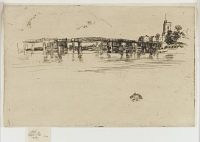Little Putney Bridge | ||
| Number: | 186 | |
| Date: | 1879 | |
| Medium: | etching and drypoint | |
| Size: | 132 x 207 mm | |
| Signed: | butterfly at lower right (2-final) | |
| Inscribed: | no | |
| Set/Publication: | Printseller's Association, 1879; F. Wedmore, 1883 | |
| No. of States: | 5 | |
| Known impressions: | 56 | |
| Catalogues: | K.179; M.176; W.146 | |
| Impressions taken from this plate (56) | ||
KEYWORD
barge, bridge, church, river, riverscape.
TITLE
There are three possible alternative titles, as follows:
'The Little Putney' (1879, Grosvenor Gallery). 3
'Little Putney Bridges' (1879, Whistler). 4
'The Little Putney' (1886, Frederick Wedmore (1844-1921)). 5
'The Little Putney, No. 1' (1909, Howard Mansfield (1849-1938)). 6
The first title used by Whistler is 'The Little Putney' and that was taken up by Wedmore, but the title of the etching as listed for publication by the Fine Art Society was 'Little Putney Bridge'. There are three etchings of the same subject, and naturally the title is similar: Old Putney Bridge 185, The Little Putney 187 and this one. This etching is small and does show the bridge, and so 'Little Putney Bridge' is the preferred title.
'The Little Putney' (1879, Grosvenor Gallery). 3
'Little Putney Bridges' (1879, Whistler). 4
'The Little Putney' (1886, Frederick Wedmore (1844-1921)). 5
'The Little Putney, No. 1' (1909, Howard Mansfield (1849-1938)). 6
The first title used by Whistler is 'The Little Putney' and that was taken up by Wedmore, but the title of the etching as listed for publication by the Fine Art Society was 'Little Putney Bridge'. There are three etchings of the same subject, and naturally the title is similar: Old Putney Bridge 185, The Little Putney 187 and this one. This etching is small and does show the bridge, and so 'Little Putney Bridge' is the preferred title.
3: London Grosvenor 1879 (cat. no. 272).
4: List, 14-15 August 1879, GUW #13019.
5: Wedmore 1886 A[more] (cat. no. 146).
6: Mansfield 1909[more] (cat. no. 176).
DESCRIPTION
The River Thames takes up the bottom half of the plate. The wooden bridge, with its slightly curving central span supported on iron columns, is etched in the top half, with lightly etched reflections below. The left end of the bridge is not seen. At far right is a narrow, square church tower among trees, and some buildings are seen beyond it, on the right bank.
SITE
The bridge over the River Thames linking Putney on the south side with Fulham to the north, in London, UK. The timber bridge was built by a master carpenter, Thomas Phillips, to a design by the architect Sir Jacob Ackworth, and opened in 1729. It was a toll bridge, with tollbooths at either end. It was damaged by a river barge in 1870, and although repaired, it was eventually demolished and replaced by the present stone bridge in 1886. It may be that Whistler thought it worth recording the old bridge before it was demolished, as he had with Old Battersea Bridge 188.

The Thames at Putney Bridge, Morning, 2009.
Photograph © M.F. MacDonald, Whistler Etching Project.
The view is taken from about half a mile east of the bridge, towards Chelsea. It may have been drawn from steps or from the river bank. At left, the church and tower of St Mary's is seen on the south side (on the north is the church of All Saints, which also has a slender tower).
